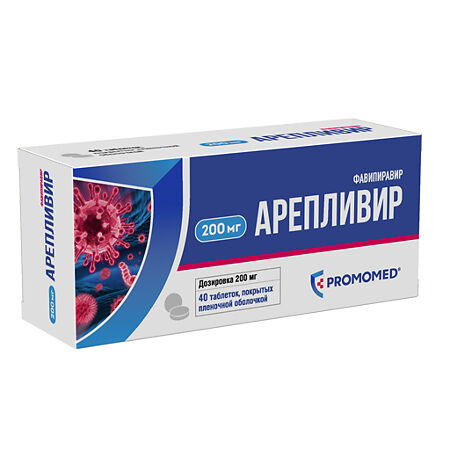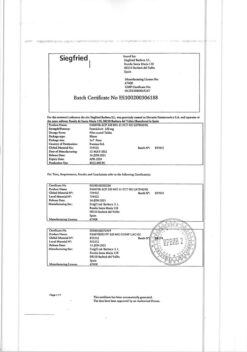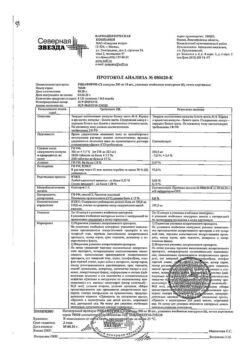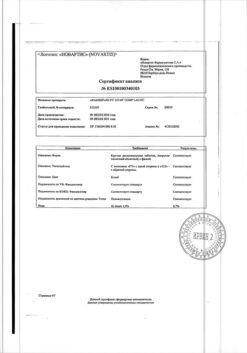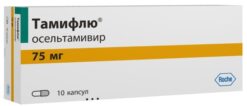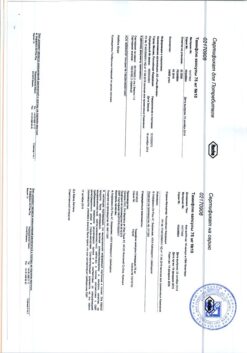No products in the cart.
Description
Pharmacotherapeutic group: antiviral medicine
ATX code: J05AX27
Pharmacological properties
Pharmacodynamics
Antiviral activity in vitro
Favipiravir has antiviral activity against laboratory strains of influenza A and B viruses (half maximum effective concentration (EC50) 0.014-0.55 µg/ml).
For influenza A and B virus strains resistant to adamantan (amantadine rimantadine), oseltamivir or zanamivir, the EC50 is 0.03-0.94 µg/mL and 0.09-0.83 µg/mL, respectively. For influenza A virus strains (including strains resistant to adamantan, oseltamivir, and zanamivir) such as swine influenza type A and avian influenza type A, including highly pathogenic strains (including H5N1 and H7N9), the EU50 is 0.06-3.53 µg/ml.
For influenza A and B virus strains resistant to adamantan, oseltamivir, and zanamivir, the EC50 is 0.09-0.47 µg/mL; no cross-resistance is observed.
Favipiravir inhibits the SARS-CoV-2 virus that causes new coronavirus infection (COVID-19). The EC50 in Vero E6 cells is 61.88 μmol, corresponding to 9.72 μg/mL.
Mechanism of Action
Favipiravir is metabolized in cells to favipiravir ribosyltriphosphate (favipiravir RTF) and selectively inhibits the RNA-dependent RNA polymerase involved in influenza virus replication. Favipiravir RtF (1000 μmol/L) showed no inhibitory effect on human α DNA, but showed inhibitory effects ranging from 9.1% to 13.5% on β and from 11.7% to 41.2% on human γ DNA. The inhibitory concentration (IC50) of Favipiravir RTP for human RNA polymerase II was 905 μmol/L.
Resistance
After 30 transfections in the presence of favipiravir, no changes in the susceptibility of influenza A viruses to favipiravir were observed, and no resistant strains were observed either. No influenza viruses resistant to favipiravir have been observed in clinical studies.
Pharmacokinetics
Intake
Favipiravir is easily absorbed in the gastrointestinal tract. Time to reach maximum concentration (Tmah) 1.5 h.
Distribution
The binding to plasma proteins is about 54%.
Metabolism
Favipiravir is primarily metabolized by aldehydoxidase and partially metabolized to the hydroxylated form by xanthine oxidase. In cells the RTP of favipiravir is metabolized. Of the other metabolites, in addition to hydroxylate, glucuronate conjugate was also recorded in human plasma and urine.
Favipiravir is mainly excreted by the kidneys as the active metabolite hydroxylate, a small amount unchanged. The elimination half-life (T1/2) is about 5 h.
Patients with impaired liver function
When favipiravirvir is taken by patients with mild to moderate hepatic impairment (Child-Pugh class A and B) increases Cmax and AUC were 1.5-fold and 1.8-fold, respectively, compared with healthy volunteers. These increases in Cmax and AUC for patients with severe hepatic impairment (Child-Pugh class C) were 2.1-fold and 6.3-fold, respectively.
Patients with renal impairment
In patients with moderate renal impairment (GFR < 60 ml/min and ≥30 ml/min) the residual concentration of favipiravir (Cthrough) was increased 1.5-fold compared to patients without renal impairment. In patients with severe and terminal renal impairment (FFR < 30 ml/min) the drug has not been studied.
Indications
Indications
Treatment of a new coronavirus infection (COVID-19).
Active ingredient
Active ingredient
Favipiravir
Composition
Composition
Per 1 tablet:
Active substance:
Favipiravir – 200.0 mg
Particular excipients:
Povidone (K-30), colloidal silicon dioxide, low-substituted hyprolose, microcrystalline cellulose (type 101), crosspovidone, stearic acid.
Film coating:
Finish film Opadray® 03F220114 yellow [Hypromellose, titanium dioxide, macrogol 4000 (Polyethylene glycol 4000), iron oxide yellow dye E172].
How to take, the dosage
How to take, the dosage
Ingestion, 30 minutes before meals.
The following dosing regimen is recommended for the treatment of new coronavirus infection (COVID-19) caused by SARS-CoV-2:
– For patients weighing < 75 kg, 1600 mg (8 tablets) 2 times on day 1 of therapy, then 600 mg (3 tablets) 2 times daily, respectively, from day 2 to day 10 of therapy;
– for patients with body weight ≥75 kg: 1800 mg (9 pills) 2 times on day 1 of therapy, then 800 mg (4 pills) 2 times a day, respectively, from day 2 to day 10 of therapy.
The drug should be taken on the basis of the clinical picture and/or after laboratory confirmation of the diagnosis and in the presence of characteristic clinical symptoms.
The total duration of therapy is 10 days or until elimination of the virus, if earlier (two consecutive negative PCR results at least 24 hours apart).
Interaction
Interaction
Favipiravir is not metabolized by cytochrome P450, mainly metabolized by aldehydoxidase and partially by xanthine oxidase. Favipiravir inhibits aldehydoxidase and cytochrome CYP2C8, but does not induce cytochrome P450.
Table 2. Interdrug interactions
Medications | Signs, symptoms, and treatment | Mechanism of action and risk factors | ||||
Pyrazinamide | Hyperuricemia | Additionally, uric acid reabsorption in the renal tubules is increased. | ||||
Repaglinide | Blood concentrations of repaglinide may increase, adverse reactions to repaglinide may occur | Repaglinide | Inhibition of CYP2C8 leads to increased blood concentrations of repaglinide. | |||
Theophylline | Favipiravir blood concentrations may be elevated, and adverse reactions to favipiravir may occur < | Interaction with xanthine oxidase may increase the blood concentration of favipiraviravir. | ||||
Famcyclovir, sulindac | The efficacy of these medications may be reduced < | Inhibition of aldehydoxidase by favipiravir may result in decreased concentrations of the active forms of these drugs in the blood. |
.
Special Instructions
Special Instructions
If side effects develop, they should be reported for pharmacovigilance measures.
Because animal studies of favipiravir have shown embryo death and teratogenicity, AREPLIVIR should not be given to pregnant women or women who are presumptively pregnant.
(1) When AREPLIVIR is prescribed to women who are fertile (including those less than 2 years postmenopausal), a negative pregnancy test must be confirmed before starting treatment. Women who are capable of childbearing should be fully explained the risks and carefully instructed to use the most effective contraceptive methods with their partners while taking the drug and for 1 month afterwards (condom with spermicide). If there is a suspicion of possible pregnancy, it is necessary to stop taking the drug immediately and consult a doctor.
2) When distributed in the human body, favipiravir gets into the semen. When prescribing the drug to patients, men should be fully explained the risks and carefully instructed to use the most effective methods of contraception during sexual intercourse while taking the drug and for 3 months after its completion (condom with spermicide). Additionally, male patients should be instructed not to have sexual contact with pregnant women.
3) When distributed in the human body, favipiravir passes into breast milk. When prescribing the drug to breastfeeding women, the risks should be fully explained and breastfeeding should be carefully instructed to stop for the duration of the drug and for 7 days after it ends.
Impact on driving, operating machinery
Cautious driving and operating machinery should be observed.
Synopsis
Synopsis
The tablets are round, biconvex, film-coated, light yellow in color. On the cross section the nucleus is white or almost white.
Contraindications
Contraindications
Hypersensitivity to favipiravir or any component of AREPLIVIR.
Severe hepatic impairment (Child-Pugh class C).
Severe and terminal renal failure (GFR < 30 ml/min).
Pregnancy or pregnancy planning.
The period of breastfeeding.
Children under 18 years of age.
With caution
. In patients with a history of gout and hyperuricemia (elevated blood uric acid levels and exacerbation of symptoms may occur), elderly patients, patients with mild to moderate hepatic impairment (Child-Pugh class A and B), patients with moderate renal impairment (GFR < 60 ml/min and ≥30 ml/min).
Side effects
Side effects
In the clinical study of AREPLIVIR the incidence of patients with reported adverse events was 24.04% (25/104). Increased alanine aminotransferase (ALT) activity was observed in 17.3% (18/104) of patients, increased aspartate aminotransferase (AST) activity in 12.5% (13/104) and increased creatine phosphokinase activity in 0.9% (1/104) of patients. These adverse reactions correspond to the known adverse drug reactions of favipiravir presented in Table 1.
The evaluation of the incidence of adverse reactions is based on the WHO classification: Very common (≥1/10); common (≥1/100, < 1/10); infrequent (≥1/1000, < 1/100); rare (≥1/10000, < 1/1000); very rare (< 1/10000); frequency unknown (it is not possible to establish frequency from available data).
Table 1. Adverse reactions
Classification by organ system | Adverse reactions | |
Blood and lymphatic system disorders | often: neutropenia, leukopenia rarely: leukocytosis, monocytosis, reticulocytopenia | |
Metabolic and nutritional disorders | often: hyperuricemia, hypertriglyceridemia infrequent: glucosuria rarely: hypokalemia | |
Immune system disorders | infrequent: rash rarely: eczema, itching | |
Respiratory system, thoracic and mediastinal disorders | rarely: bronchial asthma, sore throat, rhinitis, nasopharyngitis | |
Gastrointestinal disorders | often: diarrhea infrequent: nausea, vomiting, abdominal pain rarely: abdominal discomfort, duodenal ulcer, bloody stool, gastritis | |
Liver and biliary tract disorders | often: increased ALT activity, increased AST activity, increased gamma-glutamyltransferase (GGT) activity rarely: increased alkaline phosphatase (ALP) activity, increased blood bilirubin concentration | |
Other | rare: abnormal behavior, increased creatine phosphokinase (CPK) activity, hematuria, laryngeal polyp, hyperpigmentation, impaired taste sensitivity, hematoma, blurred vision, eye pain, vertigo, supraventricular extrasystoles, chest pain |
Overdose
Overdose
There are no reports of favipiravirvir overdose.
Similarities
Similarities
Coronavir
Additional information
| Weight | 0.033 kg |
|---|---|
| Shelf life | 2 years. Do not use after the expiration date. |
| Conditions of storage | At a temperature not exceeding 25 ºC in the secondary packaging. Keep out of reach of children. |
| Manufacturer | Biokhimik JSC, Russia |
| Medication form | pills |
| Brand | Biokhimik JSC |
Related products
Buy Areplivir, 200 mg 40 pcs with delivery to USA, UK, Europe and over 120 other countries.

